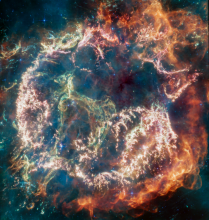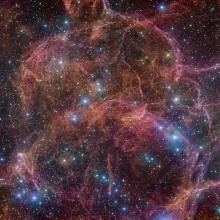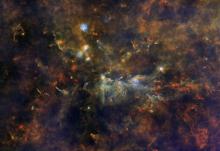Listen to today's episode of StarDate on the web the same day it airs in high-quality streaming audio without any extra ads or announcements. Choose a $8 one-month pass, or listen every day for a year for just $30.
You are here
Barnard 68
Barnard 68 is one of the darkest objects in our region of the galaxy. It’s a small cloud that absorbs the light of the stars behind it, so it looks like a dark “hole” in the Milky Way. In a couple of hundred thousand years, though, that void may shine with the warmth of newly forming stars.
Barnard 68 is a Bok globule — a small, dark sphere of gas and dust. It’s about 500 light-years away, half a light-year wide, and about three times the mass of the Sun. It’s part of a complex of dark clouds that stands in front of the glowing band of the Milky Way.
Because Barnard 68 is so dark, it’s also quite cold — temperatures at its center are not far above absolute zero. But that may be about to change.
The globule has been stable for millions of years. But there’s evidence that it’s recently been hit by a cosmic “bullet” — a smaller clump of gas and dust. That appears to be causing Barnard 68 to collapse.
As it collapses, the cloud will get denser and hotter, and perhaps split into several smaller clumps. Within a couple of hundred thousand years, the clumps could be well on their way to becoming new stars — glowing balls of gas born from a dark “hole” in the Milky Way.
Barnard 68 is in Ophiuchus, the serpent bearer, which is in the east and southeast this evening. The Milky Way runs through a corner of the constellation. Several clouds darken the Milky Way — the birthplaces of future stars.
More about Ophiuchus tomorrow.
Script by Damond Benningfield





